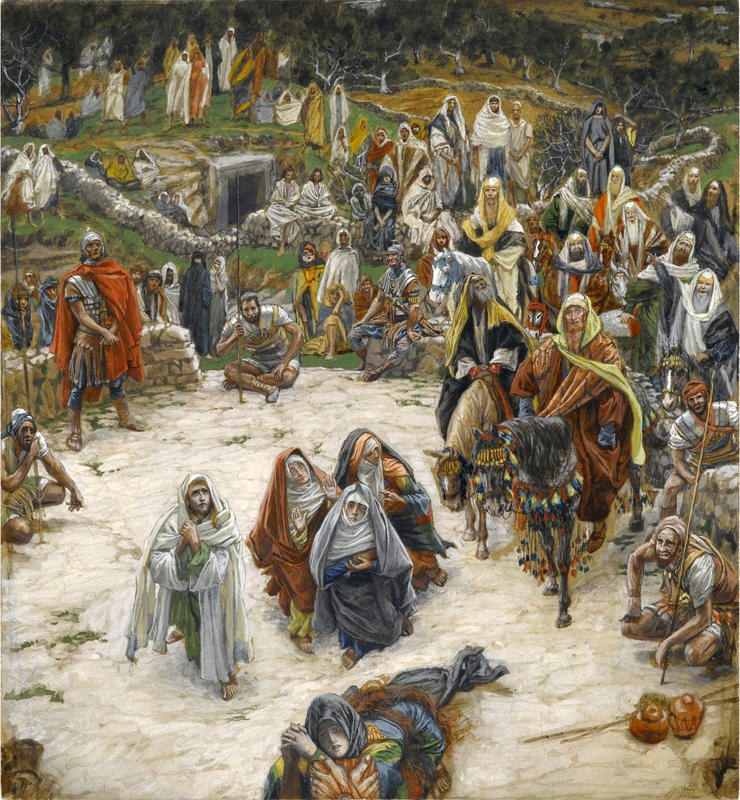More about What Our Lord Saw from the Cross

Contributor
From the fall of 1818 to the spring of 1824, the poet Clemens Brentano abandoned his flourishing career in order to copy down the visions of a sickly nun that had been marked by the stigmata, one Anne Catherine Emmerich.
She said that God had sent the romanticist Brentano so that her visions of the life and passion of Christ, bestowed upon her by the Virgin Mary, could be shared with the world. Sixty years later, James Tissot read Brentano’s account and experienced a religious conversion. From that point forward he decided to dedicate the rest of his life to illustrating the gospels, a notable change for the artist.
Prior to his conversion Tissot was known as a society painter who had found an audience in Victorian era Paris and London. Having worked regularly as a caricaturist for the magazine Vanity Fair, and having exhibited at the Royal Academy, he experienced a considerable amount of success and fame when he moved to London. There, he took up with an Irish Catholic divorcee named Kathleen Newton. Their romance was a happy one, until Newton tragically contracted tuberculosis. Struggling with Tissot's grief over her illness, Newton overdosed on the opioid laudanum in 1882.
After experiencing the suicide of his truest love, and reading Brentano’s account of Anne Catherine Emmerich's visions, Tissot had a revival of faith and his life, and artwork, changed. To get an idea of how much he turned his life around, we only need to get an idea of how much effort he put into these paintings. As opposed to some of some other artists who might have settled for a second hand account of what Israel was like, Tissot actually traveled there. He not only studied the Middle Eastern landscape and people, but also the historical clothing and architecture that would have been worn in Jesus’ time. So while the Jews in this painting might still be a bit too pale to be completely historically accurate, Tissot otherwise probably had the most accurate depictions of the Gospel at the time. This being in contrast to paintings like The Ascension by Benjamin West, or Jesus Mocked by the Soldiers by Édouard Manet, who both depict the Israelites as totally Western.
Sources
- DSPT - Dominican School of Philosophy and Theology “The Passion - James Joseph Tissot” Youtube 03/24/15 https://www.youtube.com/watch?v=-pQtnh5USRY
- Tinterow and Miller “Tea” The Met 2005 https://www.metmuseum.org/art/collection/search/438098
- Website Contributor “BIOGRAPHY OF JAMES JACQUES JOSEPH TISSOT” James Jacques Joseph Tissot: The Complete Works viewed on 09/29/2020 https://www.jamestissot.org/biography.html
Featured Content
Here is what Wikipedia says about What Our Lord Saw from the Cross

What Our Lord Saw from the Cross (Ce que voyait Notre-Seigneur sur la Croix) is a c. 1890 watercolor painting by the French painter James Tissot. The work is unusual for its portrayal of the Crucifixion of Jesus from the perspective of Jesus on the cross, rather than featuring Christ at the center of the work. The scene shows witnesses, including Jesus' followers (the women and the disciple whom Jesus loved), participants, and bystanders; of Jesus' own body only the feet can be seen, at the bottom of the picture.
The painting is part of the series The Life of Jesus Christ, a series of 350 watercolors of events from the Gospels completed by Tissot. He prepared for these by extensive travels in the Middle East to study details of contemporary life, which he used in the paintings. Prints were also published of the compositions. The whole watercolor series, completed between 1886 and 1894, was acquired in 1900 by the Brooklyn Museum in New York.
Check out the full Wikipedia article about What Our Lord Saw from the Cross












